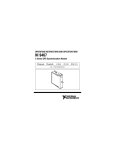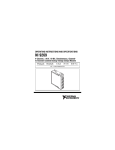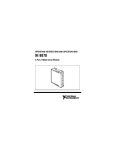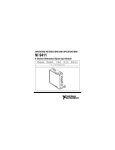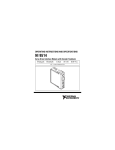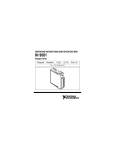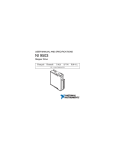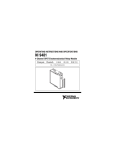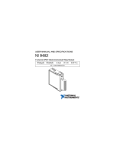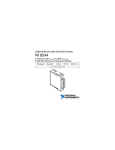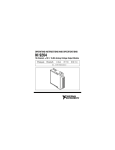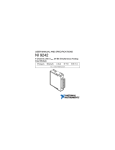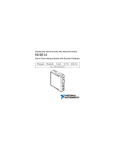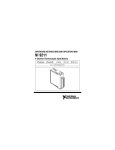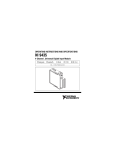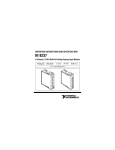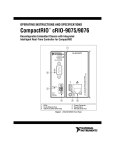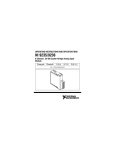Download NI 9469 Operating Instructions and Specifications
Transcript
OPERATING INSTRUCTIONS AND SPECIFICATIONS NI 9469 Synchronization Module Français Deutsch ni.com/manuals This document describes how to use the NI 9469 and includes specifications. Visit ni.com/info and enter rdsoftwareversion to determine which software you need for the modules you are using. For information about installing, configuring, and programming the system, refer to the system documentation. Visit ni.com/info and enter the following info codes: • cseriesdoc—for information about C Series and system documentation. • compatibility—for information about chassis and carrier compatibility for the modules you are using. • rdsoftwareversion—for information about which software you need for the modules you are using. Note The safety guidelines and specifications in this document are specific to the NI 9469. The other components in the system might not meet the same safety ratings and specifications. Refer to the documentation for each component in the system to determine the safety ratings and specifications for the entire system. Visit ni.com/info and enter cseriesdoc for information about C Series documentation. NI 9469 Operating Instructions and Specifications 2 ni.com Safety Guidelines Operate the NI 9469 only as described in these operating instructions. This icon denotes that the component may be hot. Touching this component may result in bodily injury. Hot Surface Caution If you need to clean the NI 9469, wipe it with a dry towel. The product must be completely dry and free from contaminants before you return it to service. Caution Do not operate the NI 9469 in a manner not specified in the user manual or operating instructions. Product misuse can result in a hazard. You can compromise the safety protection built into the product if the product is damaged in any way. If the product is damaged, return it to National Instruments for repair. Safety Guidelines for Hazardous Locations The NI 9469 is suitable for use in Class I, Division 2, Groups A, B, C, D, T4 hazardous locations; Class I, Zone 2, AEx nA IIC T4, and Ex nA IIC T4 hazardous locations; and nonhazardous locations only. Follow these guidelines if you are installing the NI 9469 in a potentially explosive environment. Not following these guidelines may result in serious injury or death. © National Instruments 3 NI 9469 Operating Instructions and Specifications Caution Do not disconnect I/O-side wires or connectors unless power has been switched off or the area is known to be nonhazardous. Do not remove modules unless power has been switched off or the area is known to be nonhazardous. Caution Substitution of components may impair suitability for Class I, Division 2. Caution For Division 2 and Zone 2 applications, install the system in an enclosure rated to at least IP 54 as defined by IEC 60529 and EN 60529. Caution Special Conditions for Hazardous Locations Use in Europe This equipment has been evaluated as Ex nA IIC T4 equipment under DEMKO Certificate No. 07 ATEX 0626664X. Each module is marked II 3G and is suitable for use in Zone 2 hazardous locations, in ambient temperatures of –40 °C ≤ Ta ≤ 70 °C. If you are using the NI 9469 in Gas Group IIC hazardous locations, you must use the device in an NI chassis that has been evaluated as Ex nC IIC T4, EEx nC IIC T4, Ex nA IIC T4, or Ex nL IIC T4 equipment. NI 9469 Operating Instructions and Specifications 4 ni.com Electromagnetic Compatibility Guidelines This product was tested and complies with the regulatory requirements and limits for electromagnetic compatibility (EMC) as stated in the product specifications. These requirements and limits are designed to provide reasonable protection against harmful interference when the product is operated in its intended operational electromagnetic environment. This product is intended for use in industrial locations. There is no guarantee that harmful interference will not occur in a particular installation, when the product is connected to a test object, or if the product is used in residential areas. To minimize the potential for the product to cause interference to radio and television reception or to experience unacceptable performance degradation, install and use this product in strict accordance with the instructions in the product documentation. Furthermore, any changes or modifications to the product not expressly approved by National Instruments could void your authority to operate it under your local regulatory rules. To ensure the specified EMC performance, operate this product only with shielded cables and accessories. Caution © National Instruments 5 NI 9469 Operating Instructions and Specifications Special Guidelines for Marine Applications Some products are Lloyd’s Register (LR) Type Approved for marine (shipboard) applications. To verify Lloyd’s Register certification for a product, visit ni.com/certification and search for the LR certificate, or look for the Lloyd’s Register mark on the product label. In order to meet the EMC requirements for marine applications, install the product in a shielded enclosure with shielded and/or filtered power and input/output ports. In addition, take precautions when designing, selecting, and installing measurement probes and cables to ensure that the desired EMC performance is attained. Caution NI 9469 Overview The NI 9469 is a synchronization module for C Series platforms. It has a configurable multi-port interface that enables distribution of triggers and clocks from a host chassis, and it has an onboard DDS and PLL for clock generation and synchronization capabilities. NI 9469 Operating Instructions and Specifications 6 ni.com Connecting the NI 9469 The NI 9469 has three RJ45 connectors on the front panel labeled Port 0, 1, and 2. These connectors use standard straight through CAT 5e Ethernet cabling to provide connection to other NI 9469 modules only. Each port is software-configurable to drive or receive 4 differential signals through the cable which are referred to as Line 0 to 3. Each port can carry either 4 triggers, or 3 triggers and 1 clock, in which Line 3 is dedicated to carry the clock. Routing the NI 9469 The NI 9469 features a configurable crosspoint switch. You can control the routing of signals and the onboard clock generator between each front port, and the trigger lines in the backplane. However, the crosspoint switch is not a full routing matrix. Only the same Line or Trig number can be connected together. For example, Line 0 to Trig 0, but not Line 0 to Trig 2. However, clock signals can only be routed on Line 3 or Trig 3. Figure 1 details the routing capabilities of the crosspoint switch. Note Only 8 of the 12 total port lines are allowed to be set as outputs due to power constraints. © National Instruments 7 NI 9469 Operating Instructions and Specifications Destinations Port 0 Line 0 Line 1 Port 1 Line 1 Port 2 Sources Line 3 Line 1 Backplane Trig 0 Trig 1 Trig 2 Onboard Trig 3 Clk Gen Trig 2 Trig 0 Line 2 Line 3 Line 1 Trig 3 Trig 1 Line 3 Line 2 Line 2 Backplane Line 3 Line 0 Line 0 Line 2 Line 2 Line 0 Port 2 Line 3 Line 1 Line 3 Port 1 Line 0 Line 1 Line 2 Line 0 Port 0 Figure 1. Routing Capabilities of the Crosspoint Switch NI 9469 Operating Instructions and Specifications 8 ni.com Note Figure 1 details hardware routing capability only. There may be software imposed limitations that prevent certain routing or input/output function from being realized. For more information refer to the documentation for your specific software platform. NI 9469 Application In a basic application, a single NI 9469 module is inserted into each host C Series chassis. One module is set as master, the remainder as slaves, and all of the modules are connected with a tree topology. Figure 2 shows a tree topology example. More advanced and customizable options are available that enable a flexible topological network of NI 9469 modules to be achieved. Refer to the Topologies section for examples of various topological networks. Based on user needs, certain topologies may be desired over others due to application or timing requirements. Since signals are physically propagated over cabling, inherent cable delays and skew exist that the module cannot compensate for. If, for example, all slave modules must receive triggers at the same time with minimal skew and delay, a star topology with short length-matched cables is preferred. Refer to Figure 3 for an example of a star topology configuration. © National Instruments 9 NI 9469 Operating Instructions and Specifications If maximum separation distance is required, connect the modules using a daisychain topology with maximum cable length per hop, as shown in Figure 4. Refer to the Cable section for information about maximum cable length. Topologies Out Out In In Out Master Out Slave Out Out Out Out Slave Chassis 1 Chassis 2 In In Chassis 5 Out In Out Out In Out Out Out Slave Slave Slave Slave Chassis 3 Chassis 4 Chassis 6 Chassis 7 In Figure 2. Tree Topology NI 9469 Operating Instructions and Specifications 10 ni.com Out Out Out Out In In Out Slave Slave Chassis 7 Chassis 2 Out In In Out Out In Out Out Out In In Slave Slave Master Slave Out Out Out Slave Chassis 1 Chassis 6 Out Out Chassis 3 In In Out Slave Slave Chassis 5 Chassis 4 Out Figure 3. Star Topology © National Instruments 11 NI 9469 Operating Instructions and Specifications In Out Out In Out Out In Out Out In Out Out In Out Out In Out Out Master Slave Slave Slave Slave Slave Chassis 1 Chassis 2 Chassis 3 Chassis 4 Chassis 5 Chassis 6 Figure 4. Daisychain Topology NI 9469 Operating Instructions and Specifications 12 ni.com Out Out In In Out Out In Out Out In Slave Slave Slave Chassis 2 Chassis 3 Chassis 4 Out Out Slave Chassis 7 In Out Out In In Out Out In Out Out Out Out Slave Master Slave Slave Chassis 6 Chassis 8 Chassis 1 In Out Out In Slave Out Slave Chassis 5 Out In Out Out Slave Chassis 9 Figure 5. Hybrid Topology © National Instruments 13 NI 9469 Operating Instructions and Specifications Activity LEDs The NI 9469 has four front panel LEDs labeled Trig 0, Trig 1, Trig 2, and Trig 3/Clk. The LEDs blink when activity is detected on the corresponding line to or from the carrier. Sleep Mode This module supports a low-power sleep mode. Support for sleep mode at the system level depends on the chassis that the module is plugged into. Refer to the chassis manual for information about support for sleep mode. If the chassis supports sleep mode, refer to the software help for information about enabling sleep mode. Visit ni.com/info and enter cseriesdoc for information about C Series documentation. Typically, when a system is in sleep mode, you cannot communicate with the modules. In sleep mode, the system consumes minimal power and may dissipate less heat than it does in normal mode. Refer to the Specifications section for more information about power consumption and thermal dissipation. Notice that when the NI 9469 is in sleep mode, the clock generation settings (if used) must be reconfigured when the module exits sleep mode and power is restored. NI 9469 Operating Instructions and Specifications 14 ni.com Specifications The following specifications are typical for the range –40 to 70 °C unless otherwise noted. I/O Characteristics Front panel connectors...................... Shielded RJ45 receptacle Front panel indicators ....................... 4 green LEDs Number of Ports................................ 3 (Port 0, 1, and 2) Number of input/output signals..... 4 (Line 0, 1, 2, and 3) per port, 12 total Signal type...................................... Differential Maximum simultaneous outputs ........................................ 8 Number of I/O triggers to backplane ...................................... 4 (Trig 0, 1, 2, and 3) Clock Generation (DDS) Frequency ................................... 12.8 MHz or 13.1072 MHz Accuracy..................................... ± 3.5 ppm typical © National Instruments 15 NI 9469 Operating Instructions and Specifications Cable Type .................................................. CAT 5e (Shielded Twisted Pair)1 (straight-through) Maximum propagation delay2 .......... 4.98 ns/m Maximum length............................... 100 m Power Requirements Power consumption from chassis Active mode ............................... 1 W max Sleep mode ................................. 25 μW Thermal dissipation (at 70°C) Active mode ............................... 1 W max Sleep mode ................................. 25 μW Physical Characteristics Weight............................................... 148 g 1 Refer to the I/O Characteristics section for more information. 2 As specified for CAT 5e in TIA/EIA-568 Standard. NI 9469 Operating Instructions and Specifications 16 ni.com Safety Safety Voltages Isolation Channel-to-channel .................... None Channel-to-earth ground ............ None Hazardous Locations U.S. (UL) .......................................... Class I, Division 2, Groups A, B, C, D, T4; Class I, Zone 2, AEx nA IIC T4 Canada (C-UL) ................................. Class I, Division 2, Groups A, B, C, D, T4; Class I, Zone 2, Ex nA IIC T4 Europe (DEMKO)............................. Ex nA IIC T4 © National Instruments 17 NI 9469 Operating Instructions and Specifications Safety Standards This product meets the requirements of the following standards of safety for electrical equipment for measurement, control, and laboratory use: • IEC 61010-1, EN 61010-1 • UL 61010-1, CSA 61010-1 Note For UL and other safety certifications, refer to the product label or the Online Product Certification section. Electromagnetic Compatibility This product meets the requirements of the following EMC standards for electrical equipment for measurement, control, and laboratory use: • EN 61326-1 (IEC 61326-1): Class A emissions; Industrial immunity • EN 55011 (CISPR 11): Group 1, Class A emissions • AS/NZS CISPR 11: Group 1, Class A emissions • FCC 47 CFR Part 15B: Class A emissions • ICES-001: Class A emissions NI 9469 Operating Instructions and Specifications 18 ni.com Note In the United States (per FCC 47 CFR), Class A equipment is intended for use in commercial, light-industrial, and heavy-industrial locations. In Europe, Canada, Australia and New Zealand (per CISPR 11) Class A equipment is intended for use only in heavy-industrial locations. Note Group 1 equipment (per CISPR 11) is any industrial, scientific, or medical equipment that does not intentionally generates radio frequency energy for the treatment of material or inspection/analysis purposes. Note For EMC declarations and certifications, and additional information, refer to the Online Product Certification section. CE Compliance This product meets the essential requirements of applicable European Directives as follows: • 2006/95/EC; Low-Voltage Directive (safety) • 2004/108/EC; Electromagnetic Compatibility Directive (EMC) © National Instruments 19 NI 9469 Operating Instructions and Specifications Online Product Certification Refer to the product Declaration of Conformity (DoC) for additional regulatory compliance information. To obtain product certifications and the DoC for this product, visit ni.com/ certification, search by model number or product line, and click the appropriate link in the Certification column. Shock and Vibration To meet these specifications, you must panel mount the system. Operating vibration Random (IEC 60068-2-64)......... 5 grms, 10 to 500 Hz Sinusoidal (IEC 60068-2-6) ....... 5 g, 10 to 500 Hz Operating shock (IEC 60068-2-27).............................. 30 g, 11 ms half sine, 50 g, 3 ms half sine, 18 shocks at 6 orientations Environmental Refer to the manual for the chassis you are using for more information about meeting these specifications. Operating temperature (IEC 60068-2-1, IEC 60068-2-2) ..... –40 to 70 °C NI 9469 Operating Instructions and Specifications 20 ni.com Storage temperature (IEC 60068-2-1, IEC 60068-2-2) ..... –40 to 85 °C Ingress protection.............................. IP 40 Operating humidity (IEC 60068-2-56).................................. 10 to 90% RH, noncondensing Storage humidity (IEC 60068-2-56).............................. 5 to 95% RH, noncondensing Maximum altitude............................. 2,000 m Indoor use only. Pollution Degree (IEC 60664) .......... 2 Environmental Management NI is committed to designing and manufacturing products in an environmentally responsible manner. NI recognizes that eliminating certain hazardous substances from our products is beneficial to the environment and to NI customers. © National Instruments 21 NI 9469 Operating Instructions and Specifications For additional environmental information, refer to the NI and the Environment Web page at ni.com/environment. This page contains the environmental regulations and directives with which NI complies, as well as other environmental information not included in this document. Waste Electrical and Electronic Equipment (WEEE) EU Customers At the end of the product life cycle, all products must be sent to a WEEE recycling center. For more information about WEEE recycling centers, National Instruments WEEE initiatives, and compliance with WEEE Directive 2002/96/EC on Waste and Electronic Equipment, visit ni.com/ environment/weee. ⬉ᄤֵᙃѻક∵ᶧࠊㅵ⧚ࡲ⊩ ˄Ё RoHS˅ Ёᅶ᠋ National Instruments ヺড়Ё⬉ᄤֵᙃ ѻકЁ䰤ࠊՓ⫼ᶤѯ᳝ᆇ⠽䋼ᣛҸ (RoHS)DŽ݇Ѣ National Instruments Ё RoHS ড়㾘ᗻֵᙃˈ䇋ⱏᔩ ni.com/environment/rohs_chinaDŽ (For information about China RoHS compliance, go to ni.com/ environment/rohs_china.) NI 9469 Operating Instructions and Specifications 22 ni.com Where to Go for Support The National Instruments Web site is your complete resource for technical support. At ni.com/support you have access to everything from troubleshooting and application development self-help resources to email and phone assistance from NI Application Engineers. National Instruments corporate headquarters is located at 11500 North Mopac Expressway, Austin, Texas, 78759-3504. National Instruments also has offices located around the world to help address your support needs. For telephone support in the United States, create your service request at ni.com/support and follow the calling instructions or dial 512 795 8248. For telephone support outside the United States, visit the Worldwide Offices section of ni.com/niglobal to access the branch office Web sites, which provide up-to-date contact information, support phone numbers, email addresses, and current events. © National Instruments 23 NI 9469 Operating Instructions and Specifications LabVIEW, National Instruments, NI, ni.com, the National Instruments corporate logo, and the Eagle logo are trademarks of National Instruments Corporation. Refer to the Trademark Information at ni.com/trademarks for other National Instruments trademarks. Other product and company names mentioned herein are trademarks or trade names of their respective companies. For patents covering National Instruments products/technology, refer to the appropriate location: Help»Patents in your software, the patents.txt file on your media, or the National Instruments Patent Notice at ni.com/patents. Refer to the Export Compliance Information at ni.com/legal/export-compliance for the National Instruments global trade compliance policy and how to obtain relevant HTS codes, ECCNs, and other import/export data. © 2012 National Instruments. All rights reserved. 373337A-01 Jun12
























